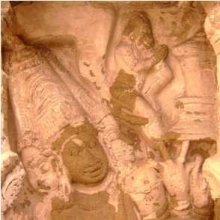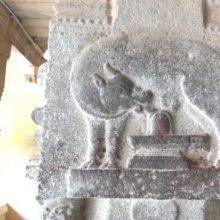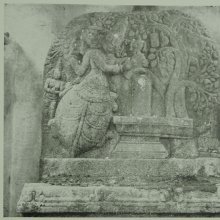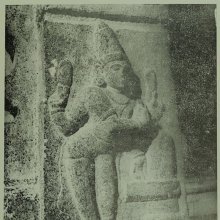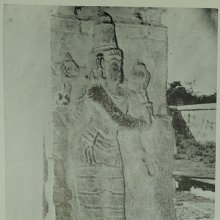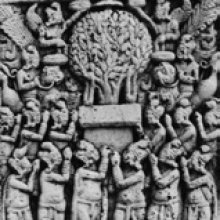Worshipping, Worshiping: 2 definitions
Introduction:
Worshipping means something in Hinduism, Sanskrit, the history of ancient India. If you want to know the exact meaning, history, etymology or English translation of this term then check out the descriptions on this page. Add your comment or reference to a book if you want to contribute to this summary article.
Images (photo gallery)
(+36 more images available)
In Hinduism
Natyashastra (theatrics and dramaturgy)
Source: Shodhganga: Elements of Art and Architecture in the Trtiyakhanda of the Visnudharmottarapurana (natya)1) Worshiping (of deities) is associated with Mukula-hasta: one of the twenty-two Single-hand Gestures (in Indian Dramas) (known as asaṃyuktahastas), according to the Viṣṇudharmottarapurāṇa, an ancient Sanskrit text which (being encyclopedic in nature) deals with a variety of cultural topics such as arts, architecture, music, grammar and astronomy.—The Viṣṇudharmottarapurāṇa suggests that the tips of all fingers of the hand should be joined together to make this posture. When the tips of all fingers are joined together, it makes a shape of a blooming bud. [...] The posture mukula-hasta is formed to show the activities like worshiping of deities and offering oblations. Moreover, to show the lotus flower this hand posture is suggested to be used in dance performance in the Viṣṇudharmottarapurāṇa.
2) Worshipping is also associated with Khaṭakāvardhamāna-hasta: one of the thirteen Combined-hand Gestures (known as saṃyuktahastas).—The word khaṭakāvardhamāna is an amalgamation of two words viz., khaṭaka and vardhamāna. The word khaṭaka denotes a half closed hand and vardhamāna means increasing. In khaṭakāvardhamāna posture both of the hands are in khaṭaka position and one hand is placed upon another. [...] According to the Abhinayadarpaṇa, this posture is used to denote coronation, worshipping, marriage etc.

Natyashastra (नाट्यशास्त्र, nāṭyaśāstra) refers to both the ancient Indian tradition (shastra) of performing arts, (natya—theatrics, drama, dance, music), as well as the name of a Sanskrit work dealing with these subjects. It also teaches the rules for composing Dramatic plays (nataka), construction and performance of Theater, and Poetic works (kavya).
India history and geography
Source: Singhi Jain Series: Ratnaprabha-suri’s Kuvalayamala-katha (history)Worshipping (of deities) refers to certain preparatory rituals performed before Sea-voyages in ancient India (known in Prakrit as: jattā, or Sanskrit: yātrā), and was vividly depicted in the Kathās (narrative poems) such as Uddyotanasūri in his 8th-century Kuvalayamālā (a Prakrit Campū, similar to Kāvya poetry).—Details of preparation for sea-voyage are given which include the following items relating to preparatory ritual and the equipment of the ship: [e.g., worshipping of deities;] [...]. When the ship was to take off auspicious musical instruments were sounded, conch-shells were blown, auspicious songs were sung, [...].

The history of India traces the identification of countries, villages, towns and other regions of India, as well as mythology, zoology, royal dynasties, rulers, tribes, local festivities and traditions and regional languages. Ancient India enjoyed religious freedom and encourages the path of Dharma, a concept common to Buddhism, Hinduism, and Jainism.
See also (Relevant definitions)
Full-text (+1235): Pujana, Arcana, Samarcana, Bhutejya, Vandana, Pujayitri, Surarccana, Namasyu, Pujaka, Puja, Sammanana, Aupasthanika, Kravana, Yajin, Gauragayatri, Yaji, Grahapuja, Suryayantra, Gurumantra, Krishnashrita.
Relevant text
Search found 237 books and stories containing Worshipping, Worshiping; (plurals include: Worshippings, Worshipings). You can also click to the full overview containing English textual excerpts. Below are direct links for the most relevant articles:
The Matsya Purana (critical study) (by Kushal Kalita)
Religious Aspects of the Purāṇas (Introduction) < [Chapter 4 - Religious aspects of the Matsyapurāṇa]
Part 3 - Śāktism: The Devī-cult < [Chapter 4 - Religious aspects of the Matsyapurāṇa]
Part 4.3b - Saubhāgyaśayana-vrata < [Chapter 4 - Religious aspects of the Matsyapurāṇa]
Dvisahasri of Tembesvami (Summary and Study) (by Upadhyay Mihirkumar Sudhirbhai)
Chapter 19 - Narration of the Greatness of the Devotion
Chapter 9 - Narration of the mention of the pilgrimage
Incorporation of Grammar in the Dvisāhasrī < [H. H. Ṭembesvāmī: Erudition]
Srila Gurudeva (The Supreme Treasure) (by Swami Bhaktivedanta Madhava Maharaja)
Difference between Aiśvarya and Mādhurya < [Chapter 2.12 - Early ISKCON Conversations with Śrīla Gurudeva]
Mukti as stated by Śrī Madhvācārya < [Chapter 1.5 - Back to Home Village]
Worship of the Demigods < [Chapter 1.3 - The Preaching of Śrī Narottamānanda Prabhu to Śrīla Gurudeva]
The Devi Bhagavata Purana (by Swami Vijñanananda)
Chapter 26 - On the narration of what are to be done in the Navarātri < [Book 3]
Chapter 19 - On the prayer and hymns to the Devī < [Book 5]
Chapter 24 - On the glory of Tulasī < [Book 9]
Chaitanya Bhagavata (by Bhumipati Dāsa)
Verse 2.5.161 < [Chapter 5 - Lord Nityānanda’s Vyāsa-pūjā Ceremony and His Darśana of the Lord’s Six-armed Form]
Verse 2.25.91 < [Chapter 25 - The Discourse on Spiritual Knowledge by Śrīvāsa’s Dead Son]
Verse 2.4.58 < [Chapter 4 - Revelation of Nityānanda’s Glories]
Related products
